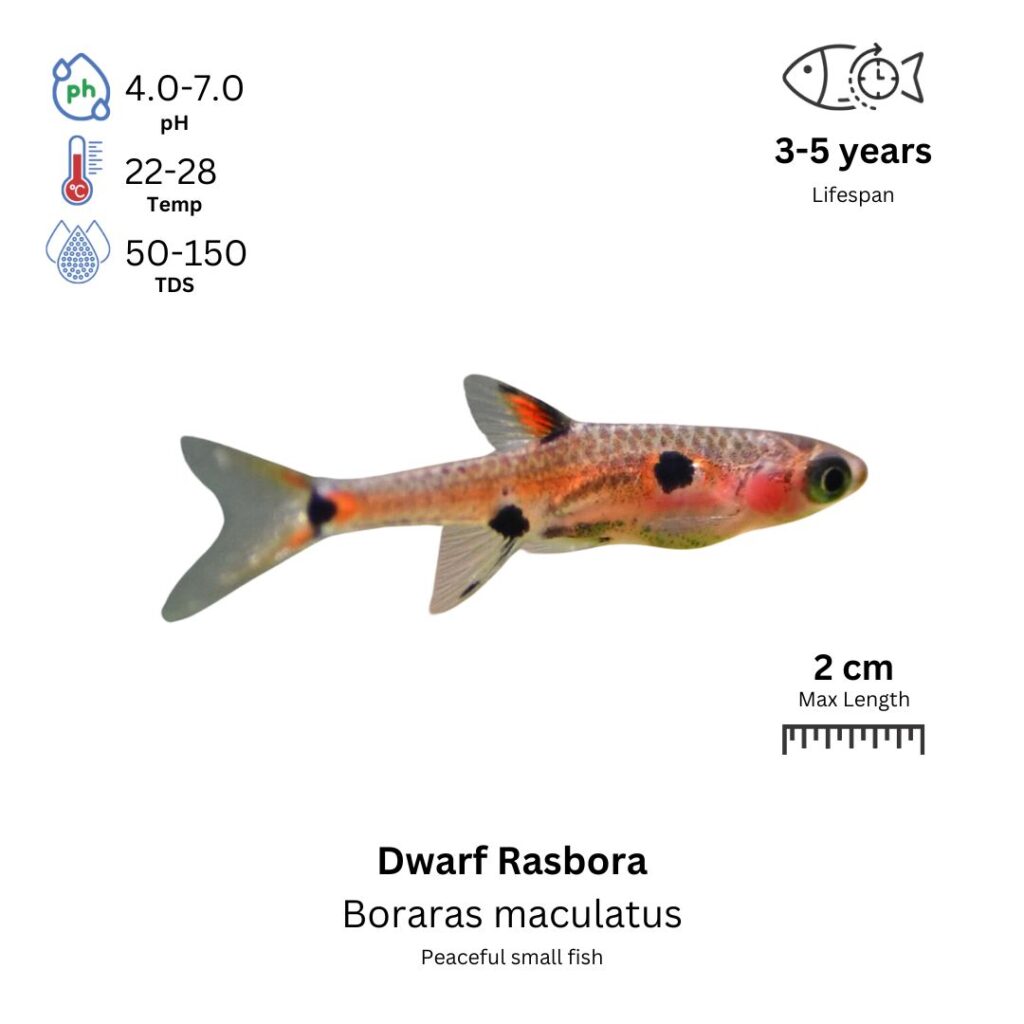Dwarf Rasbora
Boraras maculatus

Description
The Dwarf Rasbora is a tiny, vibrant fish with a translucent body that exhibits a beautiful mix of red, orange, and sometimes a golden hue. They have a characteristic black spot on their dorsal fin, adding to their striking appearance. The males tend to have more vivid coloration, particularly during the breeding season. These fish have a peaceful and active nature, and they are known for their schooling behavior. Dwarf Rasboras are best kept in small groups, where they feel secure and comfortable. Due to their small size, they are ideal for nano aquariums and planted tanks.
Habitat Origin
Native to Southeast Asia, particularly in the slow-moving streams and rivers in Thailand, Malaysia, and Indonesia. They are often found in densely vegetated waters with low to moderate flow.
Aquarium
Ideal Number in Aquarium: At least 6 individuals for optimal schooling behavior.
Favorite Food

Dwarf Rasboras are omnivores and will accept a variety of foods. They enjoy high-quality flake food, micro pellets, and live or frozen foods such as brine shrimp, daphnia, and bloodworms. They will also feed on small plant matter, including algae and biofilm.
Behavior:
Dwarf Rasboras are peaceful, active swimmers and do best in schools of at least 6 individuals. They are not aggressive and generally keep to themselves, swimming peacefully among other small, non-aggressive fish. These fish prefer the middle to upper levels of the tank but will also explore near the substrate when foraging for food. Their social nature is best expressed when kept in groups, as they tend to be shy when alone.
Special Care:
These fish do best in well-planted tanks with plenty of hiding spots, such as plants, rocks, and driftwood. A tank with stable water conditions, gentle filtration, and good oxygenation is ideal. Dwarf Rasboras are sensitive to sudden water changes, so regular, small water changes are recommended rather than large ones. They prefer slightly acidic to neutral water conditions, which mimic their natural habitat.
Compatibility with Other Fish:
Yes, they are compatible with other peaceful species, especially other small tetras, rasboras, and shrimp. Avoid keeping them with larger or aggressive fish that may view them as prey. Their small size makes them vulnerable to fin-nipping species, so it is best to house them with other small, calm fish.
Breeding Tank Setup
A dedicated breeding tank is highly recommended for Dwarf Rasboras to prevent predation of eggs and fry and to allow for optimal water control. A 5-gallon tank (19 liters) suffices for a pair or trio, while a 10-gallon tank (38 liters) is ideal for multiple pairs. Maintain pH 5.5–7.0, temperature 24–28°C (75–82°F), and hardness 2–10 dGH. Use fine gravel or sand substrate and include dense plants like Java moss or Hornwort for egg-scattering. Install a gentle sponge filter to ensure oxygenation and filtration without strong currents. Moderate lighting with a 12-hour day/night cycle supports natural behavior.
Conditioning the Breeders
To encourage breeding, feed Dwarf Rasboras a high-protein, varied diet for 5–7 days. Provide micro pellets, live or frozen foods like daphnia, brine shrimp, and microworms, and supplement occasionally with blanched vegetables like spinach or peas. Conduct 20–30% weekly water changes to maintain excellent conditions. Prior to breeding, a 50% water change and slight temperature increase (up to 28°C/82°F) can mimic rainfall and trigger spawning behavior.
Spawning Process
Spawning often takes place in the early morning or overnight following a water change. Males become more vibrant and chase females, who scatter 20–50 small, sticky eggs among plants or across the substrate. These eggs are fertilized externally. After spawning, remove the parents immediately, as Dwarf Rasboras are known to consume their own eggs, significantly reducing hatch success if left in the tank.
Fry Development
Eggs hatch within 24–36 hours, depending on water temperature. Fry initially feed on their yolk sacs and then require infusoria or liquid fry food. After a few days, introduce baby brine shrimp, microworms, or finely crushed flakes. Maintain excellent water quality with daily 10–20% water changes, and avoid overfeeding to prevent water fouling. Stable temperatures (24–28°C) and a calm environment are essential for healthy fry development.
Advanced Tips
Dwarf Rasboras reach sexual maturity at around 6 months. Males are typically smaller, slimmer, and more colorful, especially when courting. Females appear rounder and larger, particularly when gravid. Avoid sudden changes in water parameters or aggressive tank mates, as these fish are sensitive to stress and poor water quality. A peaceful, clean, and well-maintained setup is key to achieving consistent and successful breeding results.
